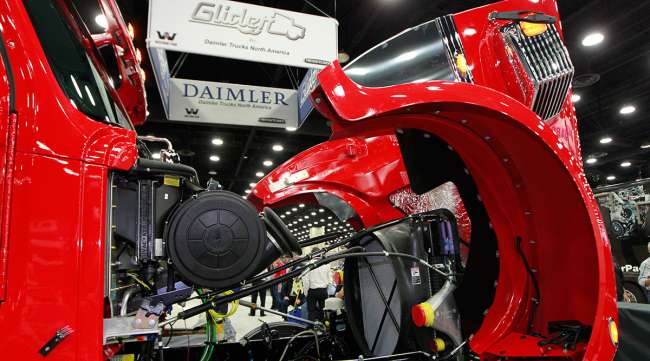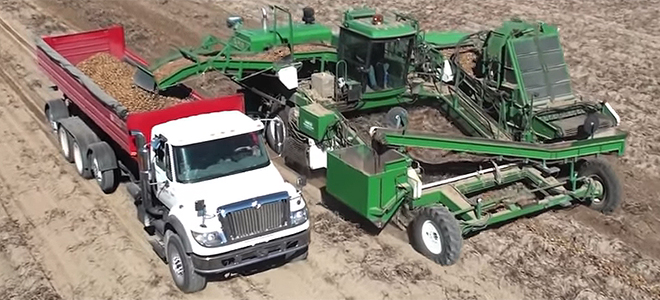Comment Period About to Close on Hotly Debated Glider Provision Repeal

WASHINGTON — Semi-trucks with trailers full of potatoes pull out of Sandyland Farms in Howard City, Mich., on a weekly basis and drive to Ohio, where processors turn the crop into potato chips.
To the untrained eye, they’re just heavy, over-the-road trucks like any other on the highway. But to the Environmental Protection Agency, the trucking industry and clean air advocates, they represent a new front in the debate over government regulation. And this week happens to be a key week for deciding how and whether trucks like these can continue to be made and sold.
Sandyland uses “gliders,” or trucks made from old, rebuilt engines and new or repuposed transmissions that are paired with new frames and cabs. Gliders provide a cost-efficient way to salvage old engines, often from a truck that was wrecked. Older engines are simpler and easier to repair because they lack computerized components. The vehicle prices can be 25% less than the sticker price of a new one, and taxes on the vehicles are lower, too.
These look like new trucks. They can have an engine life of 1 million miles before a major overhaul. Some even sport the name of a new truck or chassis maker such as Kenworth, Peterbilt or Freightliner, suggesting the strength, durability and status of a brand new diesel truck. But until now, they have only had to comply with emission rules for the year their engines were originally built.
This means that until this week, the old engines were exempt from modern, much more stringent pollution rules for new trucks. Gliders, say critics, contribute much more heavily to smog, lung disease and global warming.
President Barack Obama’s EPA aimed to change that, with a rule that took effect New Year’s Day. The rule says that if a glider maker assembles more than 300 trucks a year, the rebuilt engines on each subsequent truck must comply with emissions rules for new trucks that year.
This matters because many gliders use engines built between 1999 and 2002 or up to 2007, when emissions requirements for particulate matter started getting tougher. Rules for truck emissions such as nitrogen oxides, or NOx, toughened after 2010, when Obama announced a program of new standards for medium- and heavy-duty trucks. NOx contributes to smog and acid rain as well as particulate matter. It, too, can create serious respiratory problems.
Under subsequent Obama regulations announced in 2014, truck emissions rules for pollutants linked to global warming started ramping up even further, aiming to reach “ambitious yet achievable” levels from 2016 through 2027. But gliders were exempted — until a late-term Obama rule kicked in this week.
President Donald Trump’s EPA wants to go back to the old ways. It wants to rescind the glider rule.
If that happens, gliders once again will be covered by emission rules in place when the engines were first built. A retrofitted truck, the EPA now says, is not a new truck and should not have to comply with new truck pollution rules.

Pruitt
“The previous administration attempted to bend the rule of law and expand the reach of the federal government in a way that threatened to put an entire industry of specialized truck manufacturers out of business,” EPA Administrator Scott Pruitt said in November, announcing the proposed repeal. He has questioned both the scientific evidence for the EPA’s decision to regulate gliders as if they were new and the practical effects of the rule on small businesses and independent truck drivers.
“Gliders not only provide a more affordable option for smaller owners and operators, but also serve as a key economic driver to numerous rural communities,” Pruitt said.
Not just for poor truckers
How soon the EPA might reverse the rule is unclear, but there is urgency to do it or else glider makers will quickly be in limbo. As both sides send in public comments, which will only be accepted until Jan. 5, a window has opened on a slice of the trucking universe seldom noticed by the public.
And an unusual alliance has formed, the Lung Association’s Billings notes. New truck manufacturers, which have invested heavily to comply with emissions rules, agree with clean air advocates in an unusual display of unity: Gliders, which are cheaper than a new truck, should not get a special break on pollution.
Gliders run dirtier, this argument goes. They lack the safety components of newer trucks. The EPA tolerated them in limited numbers until now because they represented only a small slice of truck sales, and they helped people with wrecked trucks get back on the road. But they are increasingly seen as a cheap way to evade tougher and tougher emission rules, and their popularity could rise and give new truck makers and dealers stiffer — and unfair — competition.
The EPA under Obama had said that unless gliders are regulated, they could account for as much as 33% of total NOx emissions from all heavy-duty on-highway vehicles by 2025, representing an increasingly larger share of polluting trucks. This could impede the public health benefits of lower pollution levels from other vehicles, environmental health experts say.
Truck dealers have a related but different concern.
“I simply want a level playing field for fair competition in the heavy-duty truck market,” Jason Watson, president of Northern Ohio Truck Center, wrote in a letter to EPA Administrator Scott Pruitt. Watson sells Mack trucks, and Mack doesn’t make its bodies available for glider retrofits, Watson said in a phone interview.
But he has seen previous Mack customers switch to gliders when it’s time to replace their old trucks, and this worries him. Gliders are no longer just the poor trucker’s means of survival.
“Based on the variety of sales we have lost, we cannot assume that the gliders are being purchased by consumers who cannot afford a new truck or are simply buying old trucks,” he told Pruitt.
Different interests
Sandyland Farms, a family-owned, 5,000-acre, Michigan potato provider, and Northern Ohio Truck Center illustrate the contrasting positions.
Sandyland Farms employs three full-time truck drivers for its gliders, and plans to add more gliders to its small fleet.

A Sandyland Farms truck loads potatoes from a fall harvest. (Via Sandylandfarms on YouTube)
“Gliders are beneficial to our company in several ways,” Todd Young, of Sandyland, told Pruitt in a letter the week before Christmas.
Gliders are “less expensive to purchase than a new truck, creating a cost savings,” Young said. “Gliders are more fuel efficient. They are easier to repair; therefore, we can make the repairs at our shop without having to take to a dealer. In turn, having the ability to make our own repairs we have reduced our down time.”
Independent owner-operators, who own their own trucks and subcontract with companies or hire out by the load, tend to agree.
Sean Forney, a Washington state-based independent owner-operator, explained why in a letter to the EPA.
“I support the repeal, mainly because I am getting ready to take my 2000 Volvo off the road by moving the motor and transmission to a Kenworth 660 glider kit,” he said. “By doing so I hope to gain an aerodynamic improvement as well as lowering maintenance by retiring my older chassis.
“Because of the cost associated with a new truck, I am not in a position to make a purchase of a 2018 model year truck,” he said. “I’ve invested considerable monies into my motor and transmission, and they are in great working order. If the repeal does not pass, I will have to keep my vehicle on the road in its current form and condition.”
In an email to cleveland.com, Norita Taylor, spokeswoman for the Owner-Operator Independent Drivers Association, representing independent owner-operators, said, “While federally mandated emission regulations have increased the costs for buying and maintaining new trucks, many owner-operators have turned to gliders as affordable and reliable options for their businesses.”
Unfair advantages
In a landmark $1 billion 1998 settlement with the EPA during Bill Clinton’s presidency, the nation’s largest diesel truck makers agreed to better police and restrict their emissions of nitrogen oxides. And as emissions and safety rules have grown tougher, truck manufacturers have generally kept up, although not always without chafing. Under the Federal Motor Carrier Safety Administration, a rule began in December requiring that truck drivers use electronic logs that track the hours and miles driven, for example.
Trucks made before 2000 are exempt. That makes many gliders exempt, said Watson, of Northern Ohio Truck Center.
“So say I buy a new 2017 glider kit and I put my 1998 motor and transmission in it,” he said in a telephone interview. “I can now avoid electronic logs because my motor is a 1998. Now I have enabled myself to break the law again.”
Furthermore, he and others say, the federal government imposes a 12% federal excise tax on new trucks to help feed the Highway Trust Fund, which pays for new roads and bridges and repairs. Gliders aren’t considered new, so the buyers don’t pay the tax.
“While we are at an unfair 12% price disadvantage, we also miss out of the sales of the very vehicles that would be deployed in the construction and repair of the highway infrastructure because the fund is reduced with every glider vehicle sold,” Watson told the EPA.
How this ends
The EPA held a public hearing in Washington, D.C., on gliders in December. By law it must consider the views of all commenters.
But Trump and Pruitt have made clear how they feel about Obama-era regulation — it was excessive and questionable legally, they have said repeatedly. This is just one of the rules the new president is addressing.
Yet if Trump reverses his predecessor’s policy, could his decision open a new question: What, exactly, can and can’t be regulated if it isn’t considered a new motor vehicle? American Trucking Associations, a federation of trucking companies and state trucking associations, raised the concern.
“The net result would be that an engine and vehicle manufacturer could avoid all regulation of the sale of its new engines and vehicles so long as the engines used in the final assembly of otherwise brand new vehicles included at least some refurbished parts,” Glen Kedzie, a vice president for the ATA, told the EPA recently. “Creating such a loophole could potentially upend the agency’s ability to regulate emissions from the trucking sector.”
The EPA’s comment period ends Jan. 5. “Once the comment period concludes, EPA will review the input it has received and make a final decision,” the EPA said when asked about its time frame.
It did not specify a schedule for a decision, but considering that the 300-per-maker annual glider threshold is now in effect, a delayed decision is unlikely.
Distributed by Tribune Content Agency, LLC

